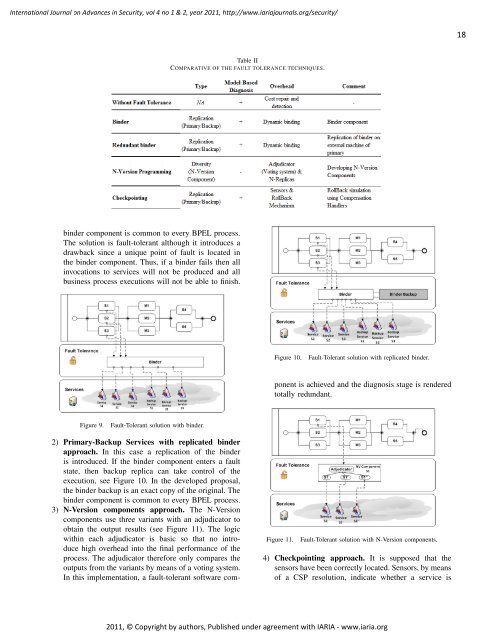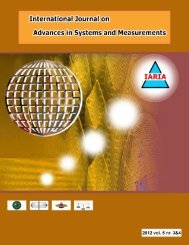Fault Tolerance Framework using Model-Based - IARIA Journals
Fault Tolerance Framework using Model-Based - IARIA Journals
Fault Tolerance Framework using Model-Based - IARIA Journals
You also want an ePaper? Increase the reach of your titles
YUMPU automatically turns print PDFs into web optimized ePapers that Google loves.
International Journal on Advances in Security, vol 4 no 1 & 2, year 2011, http://www.iariajournals.org/security/<br />
binder component is common to every BPEL process.<br />
The solution is fault-tolerant although it introduces a<br />
drawback since a unique point of fault is located in<br />
the binder component. Thus, if a binder fails then all<br />
invocations to services will not be produced and all<br />
business process executions will not be able to finish.<br />
Figure 9. <strong>Fault</strong>-Tolerant solution with binder.<br />
2) Primary-Backup Services with replicated binder<br />
approach. In this case a replication of the binder<br />
is introduced. If the binder component enters a fault<br />
state, then backup replica can take control of the<br />
execution, see Figure 10. In the developed proposal,<br />
the binder backup is an exact copy of the original. The<br />
binder component is common to every BPEL process.<br />
3) N-Version components approach. The N-Version<br />
components use three variants with an adjudicator to<br />
obtain the output results (see Figure 11). The logic<br />
within each adjudicator is basic so that no introduce<br />
high overhead into the final performance of the<br />
process. The adjudicator therefore only compares the<br />
outputs from the variants by means of a voting system.<br />
In this implementation, a fault-tolerant software com-<br />
Table II<br />
COMPARATIVE OF THE FAULT TOLERANCE TECHNIQUES.<br />
Figure 10. <strong>Fault</strong>-Tolerant solution with replicated binder.<br />
ponent is achieved and the diagnosis stage is rendered<br />
totally redundant.<br />
Figure 11. <strong>Fault</strong>-Tolerant solution with N-Version components.<br />
4) Checkpointing approach. It is supposed that the<br />
sensors have been correctly located. Sensors, by means<br />
of a CSP resolution, indicate whether a service is<br />
2011, © Copyright by authors, Published under agreement with <strong>IARIA</strong> - www.iaria.org<br />
18







